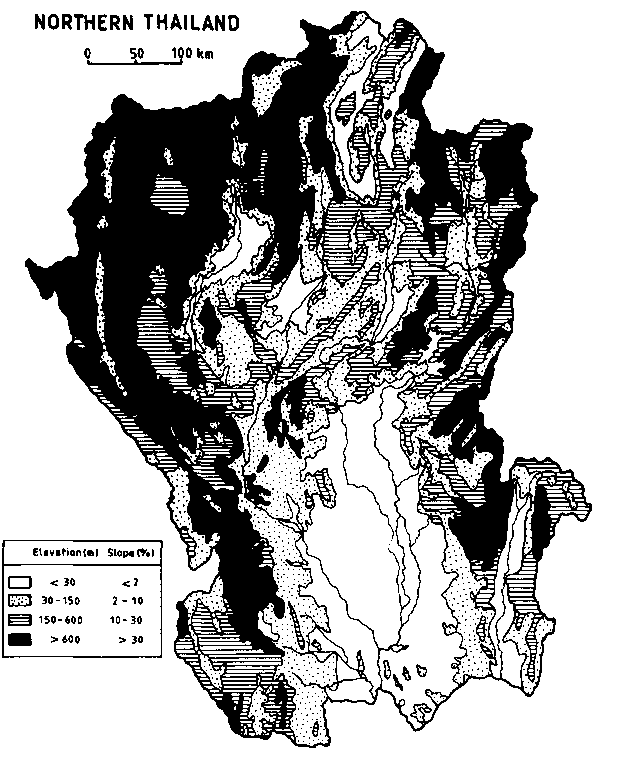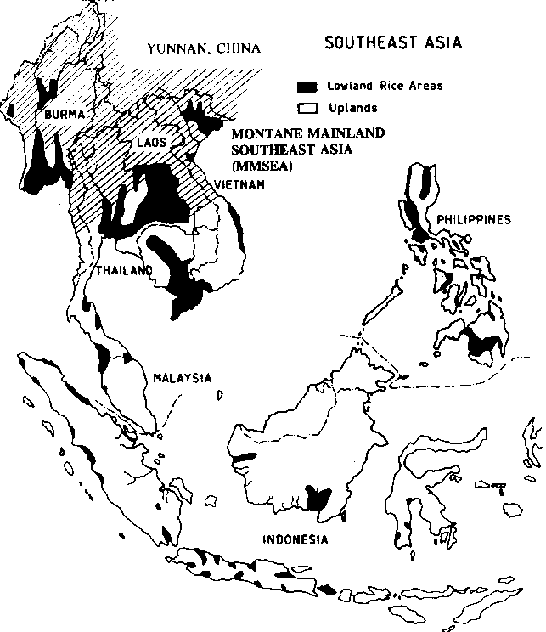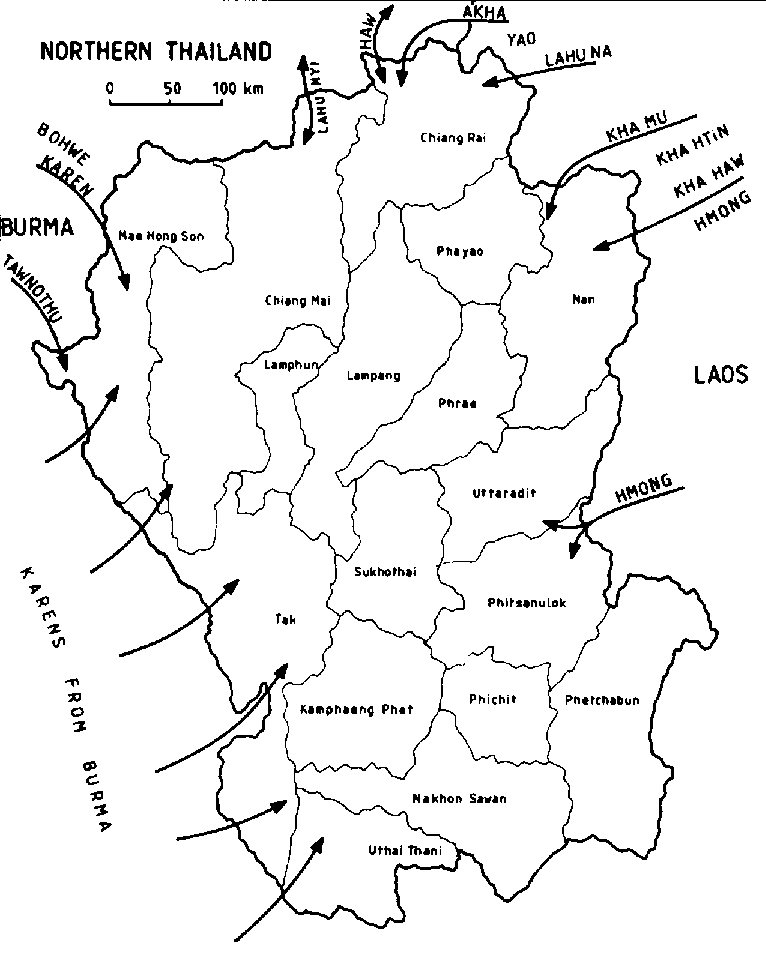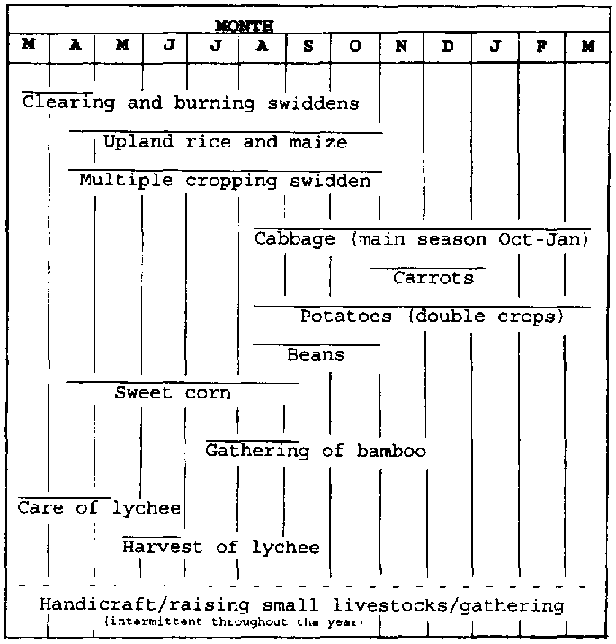This is the old United Nations University website. Visit the new site at http://unu.edu
6. Population pressure and agrodiversity in marginal areas of Northern Thailand
| Kanok Rerkasem |
Introduction
Background
Dynamics
of highland land use
Role of biodiversity in sustainable use of
marginal land
References
The highlands are among the most marginal areas in northern Thailand. Development has come in the past 30 years mainly due to national and international concerns on illicit opium cultivation by the ethnic minorities, and a national campaign against communist insurgencies. Many changes have taken place in the highlands in the last 30 years, some due to development efforts, others spontaneously. Other causes and consequences of highland development, however, are less clearly understood. A better understanding of current changes is essential for the future of sustainable development of the area.
One of the major forces behind changes in the highlands is population increase. High rates of population increase can be seen extensively in most of the highland villages. The pressure on the land is such that shifting agriculture is no longer feasible in many parts of the highlands.
Preliminary studies have suggested that this internal pressure of population increase combined with external pressures and opportunities has led to the move away from the traditional land use of shifting cultivation to more permanent land use with various levels of cropping intensification, for example multiple cropping with irrigation, mixed annual cropping of cash crops with soil and water conservation measures or fruit trees, and agroforestry systems. The advancement of the alternatives to traditional shifting cultivation has been largely depending on the local people, who have to simultaneously adapt their traditional farming systems to meet market opportunities as well as developmental policy changes. Inevitably, certain farming practices are "successful" while others have failed. Some successes are private, with a high public cost in the form of environmental and watershed degradation. Others are economically successful, while also contributing towards forest and watershed conservation.
Within the framework of the United Nations University's collaborative research on People, Land Management, and Environmental Change (PLEC), the development of production pressure and agrodiversity paradigms will be examined at the village level. Preliminary results from selected villages with productive and sustainable strategies are presented.
Until relatively recently, the concentration of the population in northern Thailand had been mostly in the alluvial plains of its major rivers (fig. 1). Although they account for three-quarters of the total land area, the highlands were largely sparsely populated. The population of the highlands has always been made up largely of people who belong to one of the ethnic minority groups (table 1). Among the major groups are Karen, Hmong, Lahu, Akha, Lisu, and Yao. These peoples form part of a much larger population of similar ethnic background that populates the mountainous area that covers the southwestern provinces of China, Laos, northern Viet Nam, Myanmar, and Thailand (fig. 2). Collectively this area could be called "Montane Mainland South-East Asia" (MMSEA). The people of this area have made their living largely from agriculture, traditionally in the form of shifting agriculture. Land use in the highlands, however, has undergone major changes, especially in the past 30 years.
In Thailand, highland development policy in the 1960s through to the early years of the 1980s was driven by two major concerns:
These have translated into programmes that have resulted in:
• improving road access and electricity supply;
• relocation of a number of villages away from the influence of the insurgence; and
• opium substitution (with alternative cash crops) and eradication (by strict law enforcement involving the army in opium poppy crops destroying operations).
Table 1 Cultural Diversity of the Ethnic Minorities in Northern Thailand (Source: Matisoff 1983)
| 1. Sino-Tibetan (Miao/Yao) | 2. Tibeto-Burman |
| Hmong | 2.1 Loloish |
| Yao | Lahu |
| Lua | Lisu |
| H'tin | 2.2 Southern LoloAkha |
| Khmu | 2.3 Lolo-BurmeseKaren? |
Figure 1 Topography of Northern Thailand

Figure 2 Distribution of Lowland Rice and Upland Areas in South-East Asia. Shaded Area Represents the Major Area of Montane Mainland South-East Asia (MMSEA) (Source: Adapted from Garrity and Sajise 1993)

At the same time, another national policy to conserve national forests and watersheds was implemented by the Royal Forestry Department. This has resulted in the establishment of national parks and wildlife reserves (totalling almost two million hectares), and designation of areas to be strictly conserved as watersheds. The major effect this has on highland land use is the restriction of access to forest land by the highland's agricultural population.
Figure 3 Changes in (a) Growing Area and Production of Poppy Opium and (b) Crop Destruction, 1965-88 (Sources: ONCB 1980 and 1988; ONCB/UNFDAC 1983)

1 rai = 0.16 ha
Many changes have taken place in the highlands in the last 30 years, some due to development efforts, others spontaneously. Illicit opium production has generally been satisfactorily curtailed through a combined effect of alternative cash cropping and strict law enforcement (fig. 3).
In addition to the "external" factors responsible for changes in the highlands mentioned above, another force was operating from within the highlands. This is the pressure exerted on the land by population increase (table 2). The population of the highlands in northern Thailand is now approaching one million. Annual growth rate between 1986 and 1993 was estimated to be 6 per cent. In some areas such as around Chiang Mai, the rate is an incredible 12 per cent (table 3). Migration is undoubtedly a major contributing factor, adding to an already high natural growth of about three per cent per year. Migration comes both from across the border from Myanmar, Laos, and sometimes as far as China, but upwards migration of lowland Thais is also significant (fig. 4).
Table 2 Highland Population in Northern Thailand (Sources: Kunstadter et al. 1978; Kunstadter 1983; NSO 1985,1986,1987; NSC/NESDB 1993)
| Year | Population |
| 1972 | 272,568 |
| 1973-77 | 306,391 |
| 1985-87 | 495,353 |
| 1991 | 749,353 |
Table 3 Population Growth in Northern Thailand
| Category | Increase per annum (%) |
| Total population | 1.1 |
| Highland population | 6.0 (1986-91) |
| Chiang Mai province | 12.0 (1985-91) |
Traditionally, shifting agriculture in northern Thailand had derived a degree of sustainability from the use of long fallow periods of 8-10 years to restore soil fertility and to keep down the population of pests and weeds. This landuse practice, however, requires much land. For example, a detailed study of a couple of Lua and Karen villages which practice sustainable rotational shifting agriculture indicated that a total of 5-6 hectares of land was required per head of the population. Pioneer shifting agriculture villages, largely belonging to ethnic groups of Hmong, Lahu, Yao, Lisu, and Akha, appeared to perceive the need to adapt to cope with the mounting pressure on the land even 30 years ago. Many of these began to buy and/or develop paddy land for wet rice and settle down to become sedentary already in the 1960s. Rotational shifting agriculture villages were already sedentary. Figure 5 presents the process in a schematic form and figure 6 shows the transect of land use in Ban Tuan of Mae Chaem district in Chiang Mai province. In the past, population increases had been managed by a group of households splitting off to form new villages. The pressure on the land is indicated by difficulties in finding new sites for these "daughter" villages. The government's forests and watershed conservation policy has further aggravated this increasing pressure on the land.
Under this increasing pressure on the land, three types of coping strategies have been identified:
Figure 4 Migration Routes of Hill Tribes in Northern Thailand (Source: Young 1974)

2. Cash cropping is adopted, sometimes with economic success, sometimes with economic failure. The resource base becomes degraded and there may also be a negative impact on the forests and watershed.
3. Adoption of sustainable land-use alternatives that are economically viable, and also have positive impacts on the forests and watersheds.
The remaining part of this paper will focus on this third strategy, examining the mechanisms by which highland land use might adapt to various external and internal pressures. Our preliminary studies have indicated that biological diversity plays a primary role in the development of sustainable landuse alternatives in the highlands.
CURRENT STATUS OF SHIFTING CULTIVATORS

Figure 5 Changes from Traditional Shifting Cultivation to Permanent Agricultural Systems in Northern Thailand
Role of biodiversity in sustainable use of marginal land
Two elements of diversity have been identified as central to the development of sustainable land-use alternatives.
Diversity of Livelihood Activities
A diversity of livelihood activities is a common feature of land use in the mountains of the MMSEA. Table 4 illustrates the degree of diversity in livelihood activities found in seven villages in northern Thailand. A "typical" farming system is engaged in six to ten activities. The performance and impact of a mountain farming system on the resource base and the environment is a combined effect of these numerous activities. Evaluating the performance of mountain farming systems and their impact may not be possible by looking at each individual activity, but has to take into account interactions among the different activities.
Agrodiversity and MMSEA PLEC in Northern Thailand
The primary hypothesis of the MMSEA PLEC project in northern Thailand is as follows:
In each farm household and each village in the highlands, these several livelihood activities are not carried out in isolation, but could be closely related. Synergies among different activities can be identified at different hierarchical levels of the agro-ecosystems, e.g. in a field, a farm, a whole village, and sometimes even among a number of neighbouring villages. (Rerkasem and Rerkasem 1995)
Figure 6 Transect of Land-use Change in Ban Tuan of Mae Chaem District, Chiang Mai Province (Source: CARE/HRIP 1994)

Examples of such interactions so far identified include for example gathering bamboo shoots from wild stands for sale in the Hmong village of Pah Poo Chom, north of Chiang Mai, which is kept below the level of "maximum sustaining yield" and is, thus, sustainable. This is partly because of a competing demand for labour for the cabbage crop (fig. 6).
Cabbage production was adopted in the Karen village at Mae Rid Pagae, in Mae Hong Son province of Thailand, as an alternative income-generating activity. It has a further impact on land productivity, as the yield of rice that followed the cabbages was doubled or tripled, presumably as the result of residual effects of cabbage fertilizers. Intensification and commercialization of highland agriculture has effectively reduced pressure on the land, simply by increasing yield per area.
Table 4 A Summary of Livelihood Activities in Seven Mountain Villages (Ethnic Groups: Hmong, Karen, Lahu, Lua) in Northern Thailand
| Activity | Degree of involvement | Contribution to income (%) | ||
| Number of villages | Households (%) | |||
| Upland rice | 7 | 76 | 10-80 | |
| Livestock | 7 | 81 | 5-50 | |
| Wage earning | 5 | 44 | 5-70 | |
| Wetland rice | 4 | 64 | 25-70 | |
| Cabbages | 3 | 52 | 5-50 | |
| Fruit trees | 3 | 48 | 10-70 | |
| Soya beans | 1 | 75 | 15-25 | |
| Chillies | 1 | 95 | 10-50 | |
| Flowers | 1 | 5 | 10 | |
| Minor crops | 2 | 45 | 5-30 | |
| Teak harvesting | 1 | nd | nd | |
| Opium | 1 | nd | nd | |
| Swidden crops | 5 | 100 | nd | |
| Gathering | ||||
| for subsistence | 7 | 100 | nd | |
| for sale | 3 | 60 | 5-30 | |
| Handicrafts | ||||
| for own use | 7 | 100 | nd | |
| for sale | 3 | 53 | 5-25 | |
1. Data in table 4 were obtained from interviews with a sample of farmers, individually and in groups, in seven mountain villages in northern Thailand, representing 10-20 percent of the population in each village. The farmers were asked to list all daily activities considered to contribute to their living, and to give each a rating in contribution to their annual income, in cash and kind, relative to the most common crop, usually rice. Some activities were not quantified, i.e. not determined (nd). Household activities, like cooking, cleaning, washing, raising children, house repair, were not considered.
2. Number of villages in which the activity was found.
3. Percentage of households involved in the villages where the activity was practised.
In Pah Poo Chom, which was on the brink of collapse in 1970 as the result of a decline in land productivity, cash cropping with irrigated cabbages and Iychee combined with bamboo shoots gathering, has significantly alleviated pressure on the land and enabled the village to allow the forest to regenerate in the major part of its former shifting agriculture area. On the other hand, in many cases intensification and commercialization have also led to a loss of genetic resources of many domesticated species, for example sesame, chillies, legumes, and traditional vegetables, and indigenous knowledge on their use and management, with a more direct effect on the loss of nutritional diversity and security.
Figure 7 Activity Calendar of Pah Poo Chom Village (Source: Rerkasem and Rerkasem 1994)

Within the framework of PLEC, this hypothesis will be tested in more quantitative detail.
CARE/HRIP. 1994. CARE Highland Resources Integration Project, Phase 111 Implementation 1992-94. Final Evaluation Report. CARE/International, Thailand, Bangkok.
Cooper, R.G. 1984. Resource Scarcity and the Hmong Response: A Study of Resettlement and Economy in Northern Thailand. Singapore University Press, Singapore.
Garrity, D. and P. Sajise. 1993. Sustainable land use systems research in Southeast Asia: A regional assessment. In: Proceedings of a Workshop on Sustainable Land Use Systems Research, 59-72. Rodale institute, Kutztown, Penn., USA.
Guo Huijun. 1993. Land Transformation: Farmers Adaptations in Southern Yunnan, China. Paper presented at the PLEC Thailand/Yunnan Second Cluster Meeting, 4 6 November 1993, Kunming, China.
KIB. 1992. Indigenous Landuse Management Systems in Yunnan. Papers presented at a seminar on Traditional Land Management, 8-14 October 1992, Kunming Institute of Botany.
Kunstadter, P. 1978. Subsistence agricultural economics of Lual and Karen Hill Farmers, Mae Sariang District, Northwestern Thailand. In: P. Kunstadter, E.C. Chapman and S. Sabhasri (eds.), Farmers in the Forest, 71-133. The University Press of Hawaii, Honolulu.
Kunstadter, P. 1983. Highland populations of northern Thailand. In: J. McKinnon and W. Bhruksasri (eds.), Highlanders of Northern Thailand, 15-45. Oxford University Press, Kuala Lumpur.
Kunstadter, P., E.C. Chapman and S. Sabhasri (eds.). 1978. Farmers in the Forest. The University Press of Hawaii, Honolulu.
Matisoff, J.A. 1983. Linguistic diversity and language contact. In: J. McKinnon and W. Bhruksasri (eds.), Highlanders of Northern Thailand, 56-86. Oxford University Press, Kuala Lumpur.
Nakano, K. 1978. An ecological study of swidden agriculture at a village in northern Thailand. Tonan Ajia Kenkyu (South-East Asian Studies) 16:411-446.
NSC (National Security Council)/NESDB (National Economic and Social Development Board). 1993. A Directory of Highland Communities and Population, 1991. NSC and NESDB, Bangkok.
NSO (National Statistics Office). 1985. Survey of Hilltribe Population, 1985 Tak Province. NSO, Bangkok.
NSO. 1986. Survey of Hilltribe Population, 1985 Chiang Mai and Phayao Provinces. NSO, Bangkok.
NSO. 1987. Survey of Hilltribe Population, 1985 Lam Pang, Sukhothai, Phetchabun, Phrae and Nan Provinces. NSO, Bangkok.
ONCB (Office of Narcotics Control Board). 1980. Opium Poppy Survey. ONCB, Bangkok.
ONCB. 1988. Opium Poppy Survey. ONCB, Bangkok.
ONCB and UNFDAC (United Nations Fund for Drug Abuse Control). 1983. A Masterplan for Opium Poppy Cultivating Regions of Thailand. ONCB and UNFDAC, Bangkok.
Rerkasem, K. and B. Rerkasem. 1994. Shifting Cultivation in Thailand: Its Current Situation and Dynamics in the Context of Highland Development. IIED Forestry and Land Use Series No. 4. International Institute for Environment and Development, London.
Rerkasem, K. and B. Rerkasem. 1995. Montane Mainland South-East Asia: Agro-ecosystems in transition. Global Environmental Change: Human and Policy Dimensions, Vol. 5, No. 4, 313 322.
Sam, D.D. 1994. Shifting Cultivation in Vietnam. Country Report, IIED Forestry and Land Use Series No. 3. International Institute for Environment and Development, London.
Souvanthong, P., S. Symmavong and K. Keosacksit. 1994. Shifting Agriculture in Laos. Paper presented at the Workshop on Shifting Agriculture, Chiang Mai University.
TDRI. 1994. Assessment of Sustainable Highland Agricultural Systems. Natural Resources and Environment Program, Thailand Development Research Institute.
Young, G. 1974. The Hill Tribes of Northern Thailand: The Origins and Habitats of the Tribes Together with Significant Changes in Their Social, Cultural and Economic Patterns. The Siam Society, Bangkok.